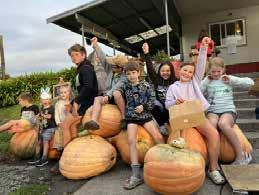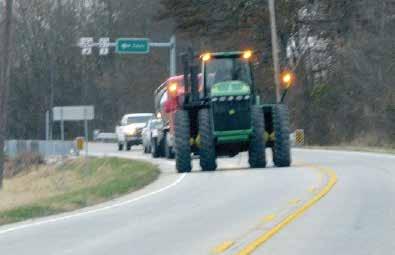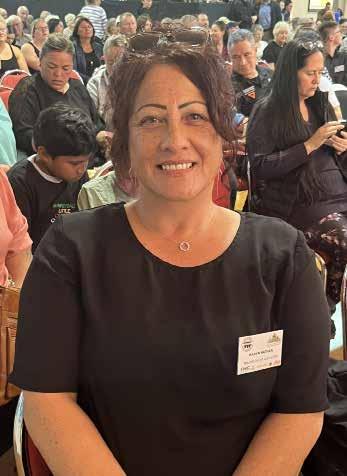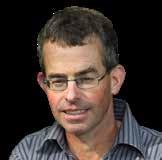Farmer King Country
Thursday, April 18, 2024


Thursday, April 18, 2024

Craig did everything he could to talk his daughter Sonya Fagan out of shearing. But there she was on stage on April 6 in the Les Munro centre in Te Kūiti, watched by a near full house, competing – in the Whānau Event with dad. So what happened? Sigrid Christiansen finds out today in a story starting on page 2.
During her childhood, Sonya Fagan’s shearing contractor dad, Craig Fagan, discouraged her from the industry.
But at the recent New Zealand Shearing Championships, Sonya gained valuable experience when they shore together in the whānau event.
She appreciates the mentoring – both in competitions and in the sheds.
“When I’m with Dad, I tell him ‘I’m having trouble here, what am I doing wrong?’ And then you do it and you click, and you’re like, ‘I just did it way faster.’”
The story begins with reluctance: on both sides.
“If I’m being brutally honest, I’ve done everything I can to talk her out of it,” Craig said.
“Because I know the reality of the industry. It’s not easy. Even as a bloke it’s tough but for women, they’ve not got the advantage of strength, and it’s tougher again.
“No one wants to see their children struggle.
But 20-year-old Sonya, who “doesn’t do things by halves,” insisted on giving it a go. And Craig ultimately picked up on her passion and became a supporter.
“Being quite headstrong, she’s decided this is the path she wants to go down. So I’ve said, OK, if you are going to go this way, the least I can do is give some insights to help you,” he said.
“I wanted to make sure this was what she really wanted to do. Because it’s not an easy road.”
At first, even Sonya herself didn’t want to go shearing.
And for some time, it wasn’t an option for her, or any of her siblings.
“We had a rule in our house that you weren’t allowed to pick up a handpiece until you were 18, because you can wreck your body if you do pick it up any sooner,” Sonya said.
That didn’t mean the young Fagans weren’t involved; Sonya started wool handling at 12. And that was behind part of her reluctance to shift to shearing.
“I didn’t really want to go into the sheds because I’d been doing it for so long and I wasn’t keen.”
She originally wanted to join the Navy, and also later went to uni, but health affected her progress in both areas.
Only after that did her mind turned to shearing.
Around that time, Craig organised for the two to go over to Australia, working in the sheds, and Sonya loved the atmosphere as a wool handler.
“Over there, you throw big Merino fleeces and there’s a lot more work to do on the fleece, they care a lot more.”
Craig suggested she “do the last side” of some of the sheep.
“When we came back, Dad said, ‘do you want to do a shearing course?’
I thought, I’ll give it a go, I thought, this could be a good way to make money and travel the world. That was in 2022.
The course was run by Piopio’s Mark Barrowcliffe. That’s when Sonya first shore a sheep by herself.





Another inspiration was record-holder Sacha Bond, who helped her choose handpieces and provided consistent encouragement.
When Sonya spoke to King Country News recently, she was back from a year overseas in Norway and the UK.
At the end of the recent Scottish main shear she shore her first 100.
“That’s the hardest tally you’ll do, because you’re not used to it. You get thrown in the deep end.”
Young shearers aspire to get there in eight hours, but Sonya did it in just six.
Since returning home this year she has shared a stand with gym buddy Chloe Bingham.
“After New Years, we both got a crack at our 200 and we both got that. We were so happy.”
Shearing has been “a bit of a journey” and frustrating at times.
“Strength is my worst challenge. I’m not a big girl – so trying to pull ewes out all day is a struggle. They can be pretty big and strong.”
Craig added, “Most of them would be bigger than her.”
Sonya said there were “no days off,” in the shearing season, with tiredness and fatigue a reality.
“You work from after New Year’s straight through to the end of January. You’ve got to have the right mindset to get past all of that.”
“The sheep do kick you and you’ve got to deal with it as well.
“If you get kicked real bad, you’ve just got to get back in your pen really.”
Sonya has collected a few shearing ribbons, placing third in the women’s event at the Gore
show. All women were in the same class.
“I was talking to my uncle David (Fagan) at the show last week. He was helping me a lot with my gear and talking to Dad on the phone trying to get me into the right headspace.
“The more practice you get, the better you will get at it. I’m just trying to learn to have fun with it instead of worrying about where I come.”
Sonya’s goal as a shearer is to do a record one day, perhaps when she’s 30. She’d also like to win one of the big shows.
“That’s the long-term goal. But who knows what’s going to happen between now and then?
“I might do a whole main shear next year and not enjoy it. But you’ve got to have a goal.”
At first it felt “very pressured” to be a Fagan starting out in shearing.
“You go up on stage and they say, ‘she’s from the famous Fagan family.’ You are really nervous, especially overseas.
“I just try not to worry about it too much. Try not to let the pressure get to you, that’s the main thing.
“That’s why I had a hard-ish couple of shows before Gore, everyone was like, ‘you should be doing better than that because you’re a Fagan.’ Her next plan is to go to the main shear in the UK. She doesn’t want to run a gang like her dad though: “that’s way too much dealing with people.”
Otherwise, she’d like to go farming and “live a simple life. You don’t have to get stressed every morning about people turning up to work.”







“This industry isn’t for everyone. It is a hard industry to get into as well – contractors will give you a job if you’re reliable and you can go somewhere in life. I’ve had a great couple of years travelling.”
“It is still harder for girls to shear than boys to shear, because you haven’t got that strength, if a girl wants to shear – I think girls are a lot
calmer than boys naturally, most of the time.”
“I love to see women shearers that come up. Me and Chloe have had the same tallies coming up through the main shear, and it’s great to see that other women shearers are happy for you.
“Any girl can conquer this job with the right mindset.”




The Climate Change Commission is considering adding emissions from international shipping and aviation to New Zealand’s 2050 carbon emissions target. Chair Rod Carr said the commission was keen to get feedback before making a recommendation.
Four contenders are in the running to be named Fonterra Dairy Woman of the Year. Myfanwy Alexander (Otago), Amber Carpenter (Auckland), Katrina Roberts (Matamata), and Michelle Ruddell (Whangarei) are chasing an award that comes with a scholarship to be part of the Kellogg
Waitanguru residents were “pumpked” about their veggie contest earlier this month, which was combined with a pot luck dinner and Easter egg hunt. Dayna Holms won the award for biggest pumpkin, with spot prizes for the smallest and most unfortunate veggies also on offer... some of which looked a little squashed.
The community enjoyed their sense of (pump)kin-ship to carve out a moment of fun.
Rural Leadership Programme. The winner will be announced in New Plymouth in early May.
Dairy farmers can expect ‘marginal’ tightening of their financial position next season with less revenue forecast, DairyNZ Head of Economics, Mark Storey says.
“We are not expecting feed and fertiliser costs to drop much further than they have already done and while debt servicing may ease, it will likely remain at very high levels,” Storey said. The breakeven milk price for the 2024-25 season is forecast to sit at around $7.76 kg/MS, while the forecast payout received is $7.79 kg/MS.
Jacqueline Rowarth has been appointed to the new Dairy NZ deputy chair position.
The farmer elected director will provide additional support in the area of stakeholder engagement chair Jim van der Poel said.
One of DairyNZ’s key roles is to put forward evidence-based solutions that work for farmers and rural communities and help move dairy farming into the future, Mr van der Poel said.
“This Deputy role will help support our
Board’s work with our sector, industry and science partners, and with local and central governments to fulfil that commitment.”
The board felt it was important to have a nominated deputy chairperson to represent DairyNZ at a governance level on issues that matter to levy-paying dairy farmers.
It was a key role to support the effort DairyNZ was putting into ensuring a thriving dairy sector for its farmers, he said.



Following three crashes involving tractors in Waikato over the Easter break, the board of Rural Contractors NZ has been discussing ways to improve safety.
A spokesperson said the subject came up at the organisation’s last regular board meeting, after three crashes on Easter Saturday.
“Board members reported feedback from contractors that it was often hard to let people pass because of road works, wire ropes, or steep banks at the sides of highways.”
The board will consult members to gather more information on how serious the problem is.
Meanwhile, a Ministry of Transport spokesperson has denied rumours that it is preparing to regulate the movement of tractors using the national roading network to move from one farm to another.
“There is not currently a review underway in relation to the rules for tractors on the road,” the spokesperson said.
“However, the Government will be considering its work programme and priorities for improving road safety over the next three years as part of developing its new road safety objectives.
“The new road safety objectives will replace Road to Zero. The Government is committed to continuing to reduce death and serious injury on our roads.”
On Easter Saturday two people were seriously injured after a car and tractor collided
on Oparure Road, near Te Kūiti.
Just 10 minutes later a motorcyclist was critically injured after a crash involving a tractor in the Matamata-Piako district. The rider later died in hospital from his injuries.
Then at 9.45pm on the same day, a tractor crashed into a car at the intersection of Pond Rd and SH 29 (the road over the Kaimai Range), leaving four people injured.
Police said they had noticed a growing number of tractors on Waikato roads as farmers took advantage of the dry weather to cut maize and make silage in preparation for winter.
“We know that it can be frustrating to be stuck behind slow-moving agricultural vehicles, but we’re asking motorists to be patient and only pass when it is safe to do so.
“Similarly, we’re asking those on agricultural vehicles to be mindful of traffic around them, and to pull over and let traffic pass when it is safe to do so.”
Police said all drivers needed to focus on the basics, including watching speed, not using the phone while behind the wheel, avoiding driving while impaired (including being fatigued), and making sure everyone had their seatbelts on.
NZTA senior media manager Andy Knackstead said in general terms, tractors being driven on a public road had to follow the same road rules as everyone else.
“They must be in good condition and be safe to use on the road. Those driving tractors are also responsible for checking that the tractor is






The Transport Agency says motorists should take extra care around tractors on the road.
not over-width and has the correct signage.
“There are tips for other road users on sharing the road with tractors in the NZ Road Code. You will sometimes see tractors and other farm or construction machinery on our roads.
“So, because they are large and usually travel slower than other vehicles, you need to be especially careful when driving near them,” Knackstead said.
NZTA recommended the following around large tractors:
• Begin to slow down as soon as you see a
tractor ahead of you and watch out for any warning beacons.
• Be patient while driving behind tractors – a few minutes of travelling at a slow speed is better than risking a crash.
• Be extremely careful when passing and only pass when it is safe and legal to do so
• Remember that tractors often have wide or long loads, which can make passing more difficult.
• Be especially careful around tractors that have just stopped, as they may actually be about to turn.





Land sales to foreign carbon farmers will be streamlined by the Government’s decision to shift the processing of applications from the Overseas Investment Office to Land Information New Zealand (LINZ). But there are polar views on whether or not the change is needed, or good. Labour Party spokesperson for land information Damien O’Connor said the move could mean less political involvement in the process of foreigners buying farmland to create carbon plantations.“Regions like the King Country could see a significant impact.“Effectively, when these changes made to the way applications are handled, foreign owned carbon companies will find it easier to purchase New Zealand farms. The government is opening the door to more foreign buyers,” O’Connor said. Normally the ministers for land information and finance give the final tick of approval for any land sales through The Overseas Investment Officeincluding the sale of farmland for conversion to forestry. But these powers would now

be delegated to LINZ. Minister for Land Information Chris Penk said the move will speed up the application process and reduce uncertainty for investors.“These changes will help encourage overseas investment which is an important part of the government’s plan to rebuild the economy so we can provide the public services that Kiwis deserve.” LINZ already make most decisions on applications, there have been no changes to the investment criteria and ministers will still have visibility of applications as they come through. Penk said ministers will still make decisions related to national security assessments and retain the ability to decide applications of particular public importance.
But O’Connor said the change was concerning and unnecessary. The Government has been “speaking out of both sides of its mouth” - with New Zealand First still saying it is out to reduce land sales to foreigners while the National seeks to increase sales to boost revenue. Federated Farmers is not concerned about the move.
“In relation to sensitive land, all this letter does is delegate approvals”, said Federated







Farmers national board member and forestry spokesperson, Toby Williams.
“It doesn’t change the criteria for assessment or anything else, and Ministers retain the right to call in an application if they feel like it.
“We would certainly be very concerned if the government were to make it easier for overseas investors to convert farms into forestry. This sort of land use change that takes out productive farmland in favour of ‘blanket’ planting of monoculture pines, especially when it’s for carbon credit income rather than for harvest of timber, undermines employment and the viability of rural communities. There are other fire risk and pest control downsides.
“But we see nothing in this that increases the risk of such applications from overseas investors gaining approval.”
The chairperson for the anti-carbon farming organisation 50 Shades of Green, Andy Scott, is also unconcerned about the changes.
“During the Labour tenure they introduced a policy that fast tracked overseas investment for forestry, however they basically excluded any overseas investment into farmland for

agricultural purposes,” Scott said.
“During Damien’s period as Minister for Agriculture there was a huge conversion to carbon farming that is now irreversible. All this did was escalate the foreign ownership and carbon farming, yet if a farmer wanted to sell the only overseas person that could purchase their land was a forestry investor. Therefore, farmland was once again made easy to purchase for carbon farming.
“Without investigating fully, I would say that this change National has put in place will make no difference to foreign ownership of farmland.
“If they make it easier for foreign investors to purchase land for farming and not the corrupt investment into carbon farming then I think that is a good thing. As when a farmer wants to exit his property for whatever reason, then it is an open market and not a biased market.
“Whatever National do to reverse the past eight years I believe will be an extraordinary hard task. I only wish that politicians would learn that a decision made has consequences and we the New Zealand public will be paying for decades.”




















Forensic work is underway to determine how an invasive weed arrived on Waikato farms –and where else it might have gone.
The discovery of velvetleaf on two new properties in the Waikato region has sparked a renewed call from Waikato Regional Council for robust biosecurity measures on farm.
Now biosecurity farm management plans are being put together to manage the risk of spread on 60 properties.
Velvetleaf is one of the world’s most invasive pest plants and its seeds remain viable for decades.
It is an annual broad-leaved herb that grows between to more than two metres in height and has buttery-yellow flowers about three centimetres across. It flowers from spring through autumn. Leaves are large, heartshaped and are velvety to the touch. A mature plant can have as many 15,000 viable seeds.
“A significant amount of work has gone into controlling velvetleaf in this region since it
52,000
was first discovered in 2011, so it is extremely disappointing to have these two new outbreaks,” said Waikato Regional Council’s biosecurity pest plants team leader Darion Embling.
“We can’t be certain how velvetleaf has spread to these two properties. However, tracing has historically identified machinery and infested maize silage as the most common vectors, which demonstrates the need for continued vigilance by farmers and growers, as well as rigorous machinery hygiene protocols by the cropping sector.
“Our focus is on tracing machinery and crop movement, which is critical to ensuring the risk of spread beyond these properties is effectively managed,” Embling said.
Velvetleaf was discovered in the region in 201 and the scale of finds escalated in 2016.
The majority of the infested properties are in the north Waikato, Matamata-Piako and south Waikato districts.
OVER two decades, two Māori land trusts, Tiroa E and Te Hape B, have supplied over 52,000 mixed breed ewes to the New Zealand Shearing Championships.
The trusts’ stations are in the Maniaiti/ Benneydale area, on te whenua o Rereahu.
Vice chairperson Karyn Nathan said the relationship between the shearing championships and the trusts led to 3000 ewes being supplied during each annual event.
However, the ability to be sponsors could not be taken for granted.
“We’ve got to acknowledge our past, and present and future owners. Because without our past owners, without their foresight, this land would have been lost,” Karyn said.
Te Hape B started supplying the ewes 20 years ago, and five years later, Tiroa E came on board.
“The relationship spans twenty years.”
“It is a great honour for us to be here tonight, supporting this kaupapa, because as a whānau business, we are supporting a whānau shearing event,” Karyn said on Saturday, April 6 at the championships.
Te Hape B trust manager for over 20 years, Ian Valler, is also a member of the shearing championships committee.
“He is able to guide our managers on farm what to select.”
Karyn described Ian as being “pivotal” to the trusts’ farming operations, saying he carried

TE HAPE B and Tiroa E Trusts have supplied over 52,000 ewes to the New Zealand Shearing Championships over a relationship spanning 20 years, said vice chairperson Karyn Nathan.
that role out successfully, with pride and mana.
“His children have grown up on our farms, on our whenua, and he’s part of the community in Benneydale and Te Kūiti.
“That’s also an achievement for us as a trust, having our managers be part of this kauapapa as well.
Fonterra has announced plans to close four plants at two Waikato manufacturing sites.
The sites – Waitoa and Te Rapa – will continue to operate.
Fonterra director NZ manufacturing Alan Van Der Nagel said the decision made was because Waitoa’s specialty powder plant and coal centre, and two powder dryers at Te Rapa were “aging assets”.
They had served well but were no longer efficient to operate.
“For these reasons, we have let our teams know of plans to close these plants.”
Staff impacted by the plant closures had
all been offered job opportunities within the co-op.
At the end of last year, Fonterra opened a wood biomass boiler at its Waitoa site allowing the co-op to transition from using coal to wood biomass to process milk.
Similar switches have seen both the Te Awamutu and Hautapu sites reducing emissions by progressing to the use of wood pellets.
At the Te Rapa site, the two dryers would discontinue operations in May.
The spokesperson said this closure would impact “fewer than 10″ staff.
A significant part of Waikato Regional Councils (WRC) catchment management programme involves helping landowners/managers to better manage erosion prone catchments, particularly in the steeper parts of the region.
Loss of productive land in our hill country is estimated to cost the economy $100 to $150 million a year. The benefits include keeping soil on the hills where it is supposed to be, and reducing sediment loss and contamination into our rivers and streams and West Coast harbour catchments.
The Waikato Hill Country erosion programme is a partnership between the Ministry of Primary Industries (MPI) and Regional Councils.
The Waikato programme involves a targeted approach in catchments with the greatest erosion risks, and aims to support landowners with a suite of mitigations, including poplar pole planting, native afforestation and land retirement and reversion to native.
In the Waipā Catchment, The Waikato River Authority and WRC with the support of the Hill Country erosion fund can work together to jointly support landowners via the Waipā Catchment Plan programme with a total of $4.15million available over the next four years.
Landowners in the Kaniwhaniwha, Moakurarua, Mangarama, Mangatea,




By Stu Kneebone Waipa/King Country Councillor Waikato Regional Council
Mangarapa, Upper Waitomo and Upper Pūniu catchments may be eligible for funding assistance. Up until June 2024 (the next two months) up to 85 per cent of the cost of work is able to be provided. However from July 2024 through to June 2027, 70 per cent funding assistance will be available.
In the West Coast catchments, WRC in partnership with the MPI Hill Country Erosion fund can support landowners from now up until June 2027. Landowners within the Mōkau, Awakino, Marokopa, Kawhia Harbour and Aotea Harbour catchments may be eligible for up to 70 per cent of the cost of fencing and planting.
The total funding available for the West Coast zone catchments (note, this
includes Whaingaroa and the northern catchments of Waimai/Mangati) is $2.7 million over the next four years.
For those with marginal steep gullies and other unproductive areas that are not really suitable for cattle, this funding assistance is worth considering.
The types of work eligible include fencing to retire steep, erosion prone land (including land with native bush on it), re-vegetation of steep, erosion prone land with natives, and poplar pole planting (with sleeves to protect them from cattle) for stabilising land slips etc.
Noting that the pending plan change regulations will require exclusion of cattle from certain streams and other waterbodies, this funding assistance will not be available for work required by regulation.
However in situations where landowners are prepared to go the extra mile and go over and above the regulatory bottom lines, demonstrate real value add for the health of a catchment, and for example create a wider riparian buffer than the regulations require, then this funding assistance can be applied.
As well as mitigating erosion risk, this work also provides a range of other benefits to help future proof farming systems in hill country, including building resilience to climate change and enhancing native biodiversity.

Trade and Agriculture Minister Todd McClay (pictured in Te Kūiti this month) was expected to return from China today (April 18) following the coalition government’s first official visit.
In Beijing, Mr McClay was to meet Minister of Commerce Wang Wentao, Minister of Agriculture and Rural Affairs Tang Renjian, as well as his counterpart for his forestry portfolio, Administrator Guan Zhi’ou.
He planned to discuss trade and agricultural relationship with China, and, in Shanghai, meet New Zealand businesses in-market, including small and medium enterprises across food and beverage, health and nutrition, services, and logistics sectors.











